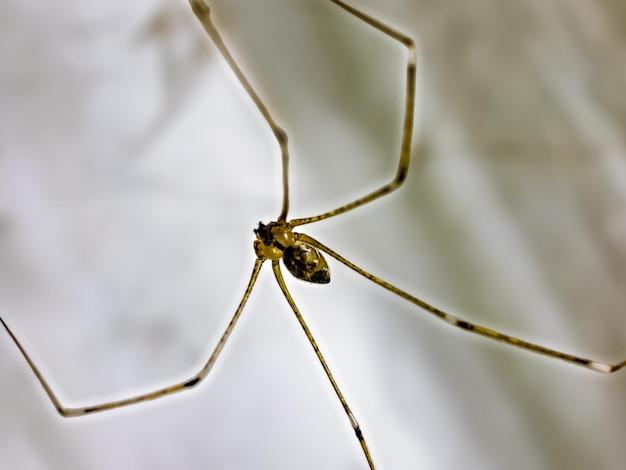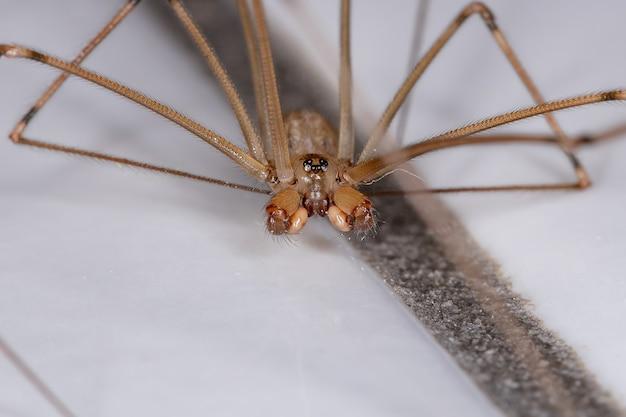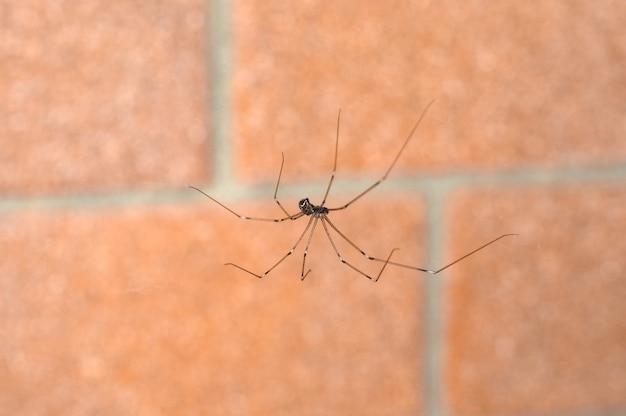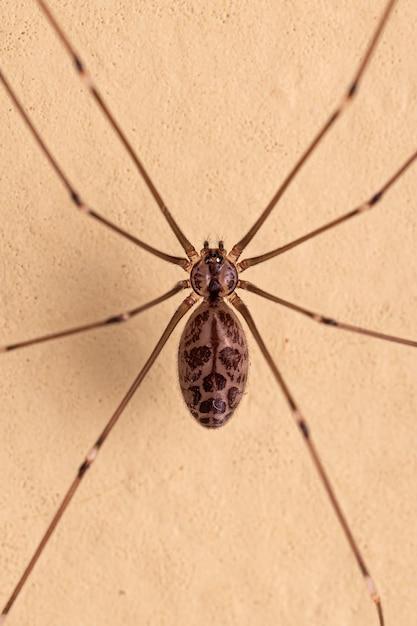If you’ve ever come across a spider with long, delicate legs scurrying across your basement or lurking in the corners of your room, chances are it could be a marbled cellar spider. These fascinating arachnids, also known as short-bodied cellar spiders, are often mistaken for their close relatives, the famous daddy long legs or even the carpenter spider. But what exactly sets them apart? And most importantly, should you be concerned about their presence? Let’s delve into the intriguing world of marbled cellar spiders and discover all there is to know about these enchanting creatures. Are they potentially dangerous? Do they serve any beneficial purpose? We’ve got you covered!
The Marbled Cellar Spider: A Fascinating Arachnid
The marbled cellar spider, scientifically known as Holocnemus pluchei, may not come to your mind when thinking about spiders. But don’t let its less-than-intimidating size fool you. This little arachnid might just surprise you with its unique characteristics and intriguing behavior. In this subsection, we explore the captivating world of the marbled cellar spider, shedding light on its appearance, habits, and interesting facts.
Appearance: A Delicate Beauty in the Cellar
At first glance, the marbled cellar spider might not make heads turn like its more colorful relatives. Its slender body measures around 8 to 10 millimeters, and its light brown to gray coloration might easily blend into its surroundings. But upon closer inspection, you’ll notice its distinctive marbled abdomen, adorned with intricate patterns that resemble the strokes of an artistic brush. The delicate beauty of this spider is truly a wonder to behold.
A Cozy Home in the Basement
The marbled cellar spider, as the name suggests, finds solace in the dark corners of our homes. It seeks shelter in cellars, basements, and other damp and dimly lit areas. These spiders are commonly found in Europe and North America, including the United States. So, the next time you venture into your basement, don’t be surprised if you stumble upon the marbled cellar spider.
Master Weaver: Intricate Webs and Hilarious Duos
One of the marbled cellar spider’s most fascinating traits lies in its web-spinning prowess. They are skilled weavers who construct intricate, tangled webs to capture their prey. But here comes the intriguing part – instead of weaving solitary webs, these spiders commonly build webs in tight clusters or communities. Yes, you heard that right. They create hilarious duos or even trios of webs, perhaps to enjoy a little company while waiting for food. Who said spiders couldn’t have a sense of humor?
A Voracious Hunter: Tiny Prey Beware!
Despite its delicate appearance, the marbled cellar spider is a voracious predator. Their diet mainly consists of small insects, making them beneficial to have around. If you’re a fruit fly or mosquito, beware! These spiders are lightning-fast and skilled hunters. They patiently wait in their intricately spun webs, ready to pounce on any unsuspecting meal that comes their way. So, maybe they deserve a little appreciation for helping us keep those annoying bugs in check.
Extraordinary Mothers: Maternal Sacrifice and Offspring Care
The marbled cellar spider showcases some extraordinary maternal behavior. The female spider invests a substantial amount of energy and effort into ensuring the survival of her offspring. She carefully spins a silk nursery, where she lays her eggs and diligently guards them. Once the spiderlings hatch, the mother continues to provide care, offering them protection and occasionally feeding them with regurgitated prey. Talk about a selfless mother!
Final Thoughts: Discovering the Marvels of the Marbled Cellar Spider
The marbled cellar spider might not be as famous as its larger and more intimidating counterparts, but it has its own unique charm and engaging behaviors. From its delicate beauty and web-spinning prowess to its quirky social dynamics and exceptional parental care, this little arachnid offers a fascinating glimpse into the world of spiders. So, the next time you spot a marbled cellar spider in your basement, perhaps you’ll greet it with a newfound appreciation for its captivating nature.
The Cunning Carpenter Spider: A Craftsperson of the Spider World
Known as the “Bob the Builder” of the spider world, the carpenter spider possesses a talent for crafting intricate webs that would make even the most seasoned weaver green with envy. With its agile eight legs and cunning hunting techniques, this spider is a true master of its craft.
Mastering the Art of Web Construction
When it comes to building webs, the carpenter spider is a true artisan. It carefully selects the perfect location, ensuring maximum visibility and optimal prey-catching potential. Using its skilled mandibles and spinnerets, the carpenter spider weaves a meticulously designed web, creating an architectural marvel that could rival the grandest of Victorian mansions.
The Secret Behind Its Craft
Craftsmanship aside, what sets the carpenter spider apart is its ability to construct various types of webs. From classic orb webs that are reminiscent of delicate lace doilies to funnel-shaped webs designed to trap unsuspecting insects, this spider’s ingenuity knows no bounds. It adapts its web construction techniques to suit its surroundings, showcasing its versatility as a true master weaver.
An Ingenious Hunter
The carpenter spider’s web is not just a pretty decoration; it’s a highly effective hunting tool. When potential prey unwittingly treads upon the web, the ingenious carpenter spider detects the smallest vibrations. With lightning-fast reflexes, it rushes towards its trapped prey, delivering a swift and precise bite. This spider doesn’t mess around – it’s a master of both construction and hunting.
The Home Improvement Enthusiast
Just like that neighbor who’s always renovating their house, the carpenter spider loves making home improvements. It can often be found in woodpiles, sheds, or even your grandmother’s antique furniture. Despite its creepy reputation, this creature actually provides a valuable service by keeping pesky insects at bay. So the next time you see a carpenter spider lurking in your home, just remember it’s doing you a favor (plus, it adds a touch of “spider chic” to your decor!).
Beware the Sly Spinster
While the carpenter spider may not be as famous as its arachnid counterparts, it deserves recognition for its exceptional craftsmanship and hunting prowess. So, the next time you stumble upon an elegantly woven web, take a moment to appreciate the artistry of the carpenter spider. After all, in the grand tapestry of the spider world, it’s a true spinster extraordinaire.
Spiders with Legs That Seem to Go On Forever
If you’re the type of person who gets a shiver down their spine at the mere sight of a spider, then you might want to brace yourself for this next subtopic – spiders with long legs. These creatures will make you wonder if they’re part spider, part stilts. But fear not, dear reader, as we introduce you to the fascinating world of spiders with legs that seem to go on forever!
The Record-Holder: Marbled Cellar Spider
Among the many different types of spiders with long legs, one stands out – the marbled cellar spider. These arachnids take leggy to a whole new level. With their eight spindly legs, these spiders have a unique way of making themselves known. Found in dark corners and crevices, they may give you a fright if you stumble upon them unsuspectingly.
Is It All Just for Show
You may be wondering why some spiders have such long legs. Are they compensating for something? Well, not exactly. While it may seem like overkill, there’s actually some logic behind their leggy appearance. These long legs serve a purpose beyond just giving us the heebie-jeebies.
Agility and Hunting Skills
Spiders, including those with long legs, are natural-born hunters. Their limbs act as multi-purpose tools, enabling them to move with remarkable agility and precision. Those long legs allow them to cover more ground and navigate intricate webs with ease. It’s like they were born to perform acrobatic stunts in their own tiny circus!
Walking on Air (Well, Almost)
Another advantage of having legs that stretch for miles is the ability to walk on air – or at least it seems that way. Spiders like the marbled cellar spider can use their legs to catch the slightest breeze and glide gracefully through the air. If you’ve ever seen a spider effortlessly descend from its web, you know what we’re talking about. It’s like a little arachnid version of Mission Impossible!
Who Needs a Personal Trainer
When it comes to leg workouts, spiders with long legs don’t have to worry about hitting the gym. Their daily routines of hunting, building intricate webs, and exploring their surroundings keep their legs in tip-top shape. Talk about the ultimate leg day! These spiders have mastered the art of legwork, making even the most intense squats seem like child’s play.
Spiders with Long Legs and a Sense of Style
If spiders with long legs weren’t impressive enough, they’ve also got a sense of style. Well, sort of. Some species decorate their leggy appendages with debris, camouflaging themselves like the fashionistas of the spider world. Just imagine strutting your stuff with a trail of leaves, twigs, and other assorted items trailing from your legs – talk about a unique fashion statement.
Wrapping Up
So, the next time you encounter a spider with long legs, marvel at its uniqueness rather than reaching for the nearest shoe. Remember, these leggy critters serve a purpose beyond simply sending chills down our spines. With their agility, hunting skills, and a sense of style, spiders with long legs are nature’s acrobats. And maybe, just maybe, they have a future in fashion too.
Short-Bodied Cellar Spider: The Lesser-known Cousin
When it comes to spiders, we’ve all heard about the infamous marbled cellar spider. But have you ever heard of its lesser-known cousin, the short-bodied cellar spider? No? Well, my friend, prepare to be enlightened!
What Makes the Short-Bodied Cellar Spider Unique
While their marbled relatives might hog the spider limelight, short-bodied cellar spiders have their own charm. These petite arachnids are known for their diminutive size and, you guessed it, short bodies. But don’t let their small stature fool you; they are just as fascinating as their larger counterparts.
Appearance and Habitat
Unlike their marbled cousins, short-bodied cellar spiders are often overlooked due to their unassuming appearance. With a body length averaging around 6mm, they easily go unnoticed. But if you take a closer look, you’ll spot their distinct features.
These spindly spiders have eight long, delicate legs and a compact body adorned with a variety of interesting colors. From pale yellow or light brown to hints of red or green, the short-bodied cellar spider’s appearance can be a delightful surprise.
You’ll typically find these stealthy creatures hanging out in cellars, basements, or any dark and damp corners they can find. Their natural habitat ensures they have plenty of insects to feast upon while keeping a low profile.
Spinning a Web of Wonder
Short-bodied cellar spiders are master weavers. Just like their marbled counterparts, they are capable of spinning intricate, almost artistic, webs. These webs serve both as a means to catch their prey and as a cozy retreat where they can dwell.
With their silk-spinning prowess, these spiders create a beautifully delicate sanctuary. Walking into an area adorned with their webs might catch you off guard, but it’s hard not to appreciate their craftsmanship.
A Supernatural Secret Weapon
Now, prepare yourself for a spider superpower that would make even Marvel’s Spider-Man envious! The short-bodied cellar spider, just like its marbled relative, has a hidden arsenal. These spiders possess the ability to vibrate their webs when they sense danger or prey approaching.
By creating vibrations that mimic the movement of captured insects, they lure their unsuspecting victims into their sticky grasp. Talk about a sneaky trick up their eight sleeves!
While the marbled cellar spider might steal the spotlight, the short-bodied cellar spider has its own unique characteristics and is a fascinating creature in its own right. From their petite size to their intricate web designs and hidden superpowers, these spiders deserve a moment in the spider-themed spotlight.
So, next time you wander into a dark cellar or basement, keep an eye out for these unassuming, yet captivating, short-bodied cellar spiders. You never know what secrets and surprises you might uncover!
Cellar Spider vs Daddy Long Legs
Have you ever walked into a dusty old basement only to discover creepy crawlies lurking in the corners? If so, you may have come across two similar-looking creatures: the Cellar Spider and the Daddy Long Legs. While they may appear identical at first glance, there are some key differences between these arachnids. Let’s take a closer look and uncover the truth!
Physical Characteristics
Cellar Spider: Also known as the Marbled Cellar Spider, this critter is a master of disguise. With its long, spindly legs and thin body, the cellar spider resembles its distant cousin, the Daddy Long Legs. However, when observed closely, you’ll notice its graceful marbled patterns on the abdomen.
Daddy Long Legs: Ah, the infamous Daddy Long Legs! With their delicate, elongated bodies and impossibly long legs, these creatures have become the stuff of legends. Often mistaken for cellar spiders, Daddy Long Legs actually belong to a completely different arachnid order, known as the Harvestmen.
Leg Length Contest
Now, let’s settle the age-old question: who has the longer legs? Well, while both the Cellar Spider and the Daddy Long Legs possess elongated limbs, the Daddy Long Legs takes the prize for the longest legs in relation to its body size. Talk about an arachnid with an impressive leg-to-body ratio!
Habitat and Behavior
Cellar Spider: As the name suggests, you’ll most likely find the Cellar Spider hiding in dark, damp places like basements, crawl spaces, and – you guessed it – cellars. These clever creatures construct messy webs in corners and crevices, where they patiently wait for unsuspecting prey to stumble into their trap. Don’t let their web-building skills fool you; cellar spiders are not harmful to humans.
Daddy Long Legs: Unlike the cellar spider, Daddy Long Legs prefer to hang out in a variety of habitats. They can be found lurking in leaf litter, under stones or logs, and even in your garden. These arachnids are not the web-spinning type; instead, they rely on their nimble legs to snatch up unsuspecting insects. Much like the cellar spider, Daddy Long Legs are harmless to humans, despite their fearsome appearance.
Can They Be Confused
While cellar spiders and Daddy Long Legs may share some physical features, their notable differences make it easy to tell them apart. The key distinguishing factor lies in their body structure and markings. Next time you encounter one of these eight-legged creatures, take a closer look and see if you can spot the marbled patterns on the cellar spider or the distinct body shape of a Daddy Long Legs.
So there you have it! The cellar spider and Daddy Long Legs may be distant cousins in the arachnid family, but they each have their quirks that set them apart. The next time you find yourself face-to-face with one of these fascinating creatures, you’ll be equipped with the knowledge to tell them apart like a spider expert – or at least impress your friends with some cool spider trivia!
Why is there a Cellar Spider in My Room
If you’ve ever found a cellar spider (also known as a marbled cellar spider) in your room, you’re not alone. These long-legged arachnids have a knack for finding their way into our living spaces. But why is that?
The Creepy Crawlies from Below
Cellar spiders earned their name for a reason: they love dark, damp, and undisturbed places, like basements, crawl spaces, and, yes, even your room. They’re excellent at hiding and can squeeze into tiny crevices, making it easy for them to sneak inside.
It’s All About the Food
Now, you might be wondering why a spider would choose to hang out in your room instead of a more insect-rich environment. Well, these stealthy arachnids are opportunistic hunters. They feast on a variety of small insects, including ants, flies, mosquitoes, and even other spiders.
A Room with a View (and Vittles)
Your room might be the perfect spot for a cellar spider to set up shop. It could be attracting plenty of delicious bugs for them to snack on. Does your room have a window that lets in a lot of light? It’s like an all-you-can-eat buffet for these hungry spiders. The light draws insects in, and the spiders are there to reap the benefits.
Lost and Confused
Sometimes, cellar spiders end up in our rooms by accident. They might have wandered in while exploring or hitched a ride on someone’s clothes or bags. After all, they’re not purposely seeking out your room as their dream destination. However, once they find themselves in your cozy abode, they may decide to stick around if there’s a steady supply of food.
A Friend in Disguise
Although their long, spindly legs might be a bit unnerving, cellar spiders can actually be beneficial roommates. They help keep your room free from some pesky bugs that you’d rather not have buzzing around. So, instead of squishing these arachnids, consider letting them carry out their pest control duties.
Spider Drama
Now, I know some of you might not be fans of having spiders in your space, even if they are helpful. Don’t worry; there are ways to peacefully coexist with them. You can try sealing up any cracks or openings that might be letting them in. Additionally, keeping your room tidy and reducing clutter can discourage pests, making it less appealing for spiders to call your room home.
The presence of a cellar spider in your room is often just a case of being in the wrong place at the wrong time. These stealthy arachnids are just doing what they do best: finding food and shelter. So, if you happen to come across one, instead of shrieking and reaching for a shoe, consider giving them a nod of silent appreciation for helping keep your room bug-free.
Are Marbled Cellar Spiders Poisonous
Marbled cellar spiders, also known as Holocnemus pluchei, are fascinating creatures often found lurking in dark corners and damp spaces. But amidst their web-spinning antics, one burning question arises: are these peculiar arachnids poisonous? Allow me to alleviate your spider jitters and shed some light on this hairy matter.
Myth Busting: The Venomous Truth
Let me start by debunking a common misconception – marbled cellar spiders are not poisonous to humans. Take a deep breath and relax; these eight-legged wonders are harmless little fellas. While they possess venom, it’s only potent enough to paralyze their prey, which consists mainly of small insects like ants and flies. So, unless your name is Ant Man, you have nothing to worry about.
Safety Dance: A Sting-free Encounter
If you happen to cross paths with a marbled cellar spider in your cozy abode, fret not. These arachnids are not aggressive and would rather avoid confrontation than engage in a battle royale. They prefer peaceful coexistence, so try not to disturb their webs, and they won’t bother you. Think of them as the nonchalant roommates of the spider world, quietly keeping to themselves and tidying up any unwanted pests.
Spider Feels: A Web of Intrigue
Curiosity may have killed the cat, but it certainly didn’t kill the marbled cellar spider. In fact, their intricately woven cobwebs are a marvel to behold. With delicate strands crisscrossing in an architectural masterpiece, these spiders create a tapestry that rivals any art gallery. So, next time you encounter a marbled cellar spider’s web, take a moment to appreciate its craftsmanship before giving it a gentle swipe.
Arachnid Aliases: The Many Hats of Marbled Cellar Spiders
Marbled cellar spiders go by many names, each more intriguing than the last. From the elegant “daddy long-legs spider” to the whimsical “skull spider,” their aliases capture the imagination. But make no mistake, regardless of how they are called, these spiders remain the gentle, harmless, and slightly quirky residents of your cellar.
Fear Not: A Lesson in Spider Tolerance
It’s time to overcome your arachnophobia and extend a friendly welcome to these marbled cellar spiders. Remember, they are not out to get you, and they play an important role in nature’s delicate balance. So, next time you spot one scuttling across your cellar wall, embrace the opportunity for a cohabitation that goes beyond the realm of your arachnophobia-induced nightmares.
There you have it, my friend. Marbled cellar spiders may possess venom, but it poses no threat to us humans. Feel free to appreciate their web-spinning talents and quirky charm without fear. Now, go forth, spider warrior, and coexist harmoniously with your eight-legged roommates!



